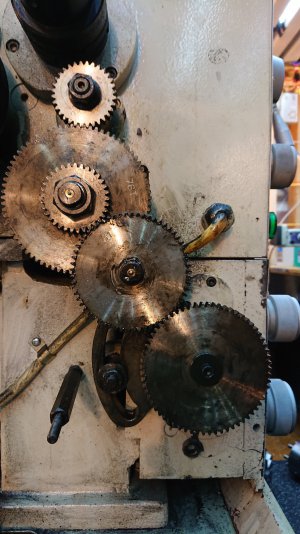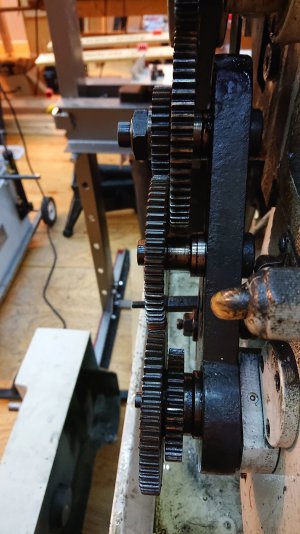FYI, threw my G0709 into FARW8 and touched off on a Dykem'd piece of Delrin. I got 0.7 mm for the thread.
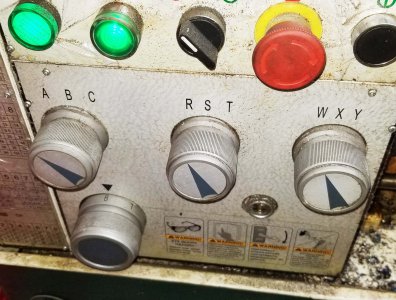
Scratch pass is spot-on 0.70 mm pitch as it should be
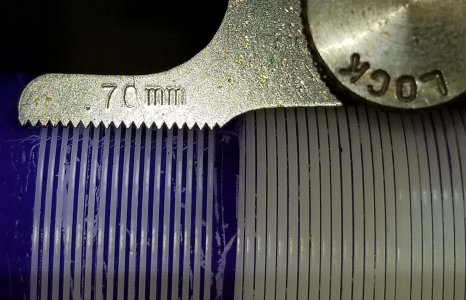
Just to verify your "8" spot, maybe try a scratch pass on FCTY8 for a 28 tpi thread?
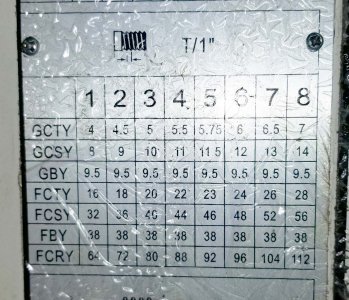
To a post above's point, this one is the half-nut lever for threading (just in case). The one to the left is the Feed Selection Lever (not for threading).
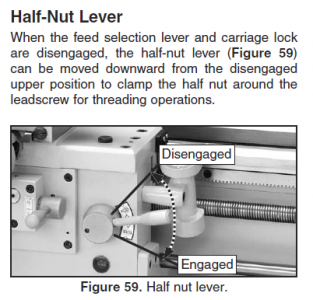
Couple of warnings about threading in general and in particular metric threading. Once I engage the feed direction knob (presumably Tail stock to head stock direction for a RH thread), I do not disengage the knob until threading is completed. Once you throw this knob, the gears on the head stock get sync'd with the gears on the quick change gear box. It's a little easier to see what's going on a lathe with an open quadrant like a South Bend or Clausing. Naturally, the head stock rotational position must be in sync with the carriage which is doing the cutting or you'll split the thread. If you disengage the feed direction knob and rotate the spindle at all, you'll very likely be out of sync when the feed direction knob is re-engaged.
On metric threads, I don't use the thread dial at all. With metric, once you engage the half-nut lever, it stays engaged. No "hitting a number" for a second pass as we have English lead screws on our lathes. Since you engage the half-nut and leave it engaged, there's really no purpose for the thread dial, so I don't loosen the cap screw and bring it into the lead screw.
On metric threading (and English), I start with the compound at a touch past the 60 deg. mark on the scale (just off the scale by 1/2 deg). A lot of import lathes (like the Grizzly) have their compound angle reference rotated 90 deg. as compared to older American models. On my Clausing 5418, 0 deg. puts the compound in line with the cross feed. On my G0709, compound at 0 degrees is in line with the longitudinal feed. There are a variety of "camps" out there: 29.5 deg., 30 deg. or straight on (cross feed only) for threading. I use 29.5 deg., relative to perpendicular to the spindle axis. On my Clausing, the compound gets set to 29.5 deg., on the Grizzly G0709, just a shade past the 60 deg. mark.
Some guys struggle with this on their import lathes as it's pretty common so set your compound to 30 deg. If you chuck up a standard bolt, the compound angle should be set so the tool will parallel the thread face on the RH side of a "V". If you set your compound on a typical import lathe to 30 deg., you'll see that the side faces of the compound and the face of the thread are off (by 30 deg.). Some guys set a 30 deg. or 29.5 deg. angle block against the face of their chuck and rotate the compound until it touches off on the opposite face of the angle block, then tighten the compound.
Anyway, once the compound is set to the proper angle, I turn the compound crank until it's at a "0". The micrometer dial is on a clutch on the G0709, just my personal preference, but I turn the crank until it's at "0" instead of turning the micrometer dial.
My cross feed micrometer dial has been modified so it uses a more conventional thumb screw. I loosen the thumbscrew so the micrometer dial turns freely. I start the lathe and advance the threading tool until it just touches the work, then set the cross feed micrometer dial to "0".
I back off the cross feed one revolution and back the carriage off the work towards the tail stock. Once off the work, turn the cross feed back to zero. Start the lathe to make sure it's in back gear, not open spindle, and turn the compound in 0.003" for a scratch pass. Engage the half-nut and power down the lathe just short of the end of your thread. You may even want to just use jog button to thread. I usually turn a relief at the bottom of the thread to just past the full thread depth before starting to thread so you have some wiggle room for stopping the lathe. If you are a little short, either jog or rotate the chuck by hand to complete the thread.
At the end of a pass, DO NOT DISENGAGE THE HALF-NUT. Turn the cross feed back out one turn (or more depending on the coarseness of the thread) and lift up on the Spindle On/Off lever which will run the lathe in reverse (run the carriage from the head stock towards the tail stock). Run it until your threading tool is just past the start of your thread and stop. Advance the cross feed one turn back to "0" on the micrometer dial. Advance the compound with a comfortable number. You'll read posts here where guys will "go for it" and advance 0.025" per pass though most are probably using a more conservative number like 0.003" - 0.005" depending on the material.
Make your next pass by either holding the jog button in or throw the Spindle On/Off lever to down or forward direction. Repeat the procedure above until you've got your thread.
If you've got an M4 nut handy, that'll work as a good gauge. Otherwise, there are other methods like thread wires, thread triangles or thread pitch micrometers. It's not uncommon to run a flat file over the thread when it's finished as the OD of the work will likely grow a little from threading.
Hope you get 'er figured out!
Bruce
